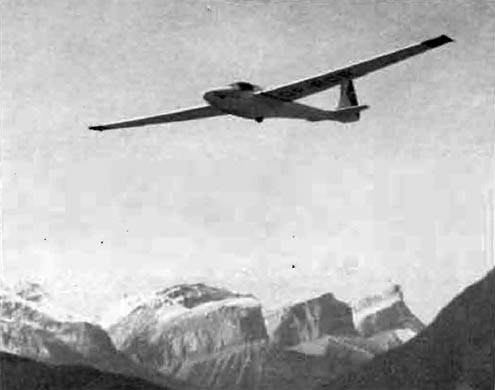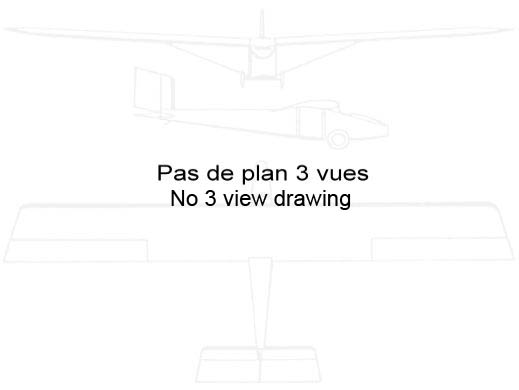
Viking 104
| DONNÉES GÉNÉRALES |
| Année du premier vol (ou de design, si seul projet) |
1960 |
| Pays | Canada |
| Designer(s) | TINGSKOU, Paul |
| Premier constructeur | PETERSON, Oscar “Pete” |
| Type d'appareil | Planeur |
| Fonction | Performance |
| SPÉCIFICATIONS TECHNIQUES |
| Envergure | -- |
| Longueur | -- |
| Hauteur | -- |
| Allongement | -- |
| Surface alaire | -- |
| Profil aile | -- |
| Masse à vide | -- |
| Masse maxi | -- |
| Charge alaire | -- |
| Vitesse mini | -- |
| Vitesse maxi | -- |
| Finesse maxi | |
| Taux de chute mini | -- |
| Nb sièges | 1 |
| Structure | Fibre de verre. |
AUTRES INFORMATIONS
| Constructeur(s) |
| ||||||
| Infos techniques | The structure was not totally of fibreglass reinforced plastic (FRP) since the wing and empennage incorporated wooden spars and ribs. Nevertheless, it was state-of-the-art in its use of FRP for glider construction and the technology as applied to the aircraft industry generally grew around the experience gained in designing gliders built with this material. Efficient use of FRP required that a prototype be constructed in hand-built molds which is a time consuming, costly process. Subsequent production models would then be more economically completed using the molds. The Viking design incorporated a molded fuselage, and all exterior surfaces of the wings and empennage were of molded skins. The glider was a cantilevered midwing single seat machine with a neatly faired fixed main wheel and nose skid. Scissors-type spoilers provided effective glide path control. | ||||||
| Histoire résumée | The Viking project was conceived in the late 1950s by an enthusiastic and dedicated group in the Edmonton Soaring Club. Paul Tingskou spearheaded developing the design concept while Oscar “Pete” Peterson tackled the construction. The prototype Viking, serial number FLS-1, was registered CF-RCR. Following test flying of this glider a decision was taken to redesign the fuselage in an attempt to reduce the empty weight. The original wings, stabilizer and elevators were fitted to a new fuselage which incorporated a neatly swept-back fin and rudder. The design objectives remained the same — the creation of a glider having docile, stable handling characteristics which would afford an easy transition from the current crop of two-seat trainers (the Edmonton club had a TG-2, a TG-3, a Pratt-Read and a 2-22 in the early 60s). The Viking was to fly as easily as a 1-26 or a 1-23, but have much higher performance. models would then be more economically completed using the molds. The Viking design incorporated a molded fuselage, and all exterior surfaces of the wings and empennage were of molded skins. The second effort produced a very attractive glider — serial number FLS-2 and registered as CF-REF in February 1962. The glider was test flown by John Pomietlarz and Ross Grady in March and April. The test reports indicated a slight reduction in the stall speed — still high at 48 mph and a tendency to roll to the left. John made 20 flights up to the end of 1963. Flight characteristics were still not up to expectations and the project faltered. Paul Tingskou became employed by Bristol Aircraft and moved to Winnipeg. The Viking did not fly in 1964. In late 1964, it was purchased by Kerry Bissell and Walt McKinnon and based at Penhold, Alberta. Kerry flew the Viking regularly and completed 98 flights in the seven year period during which he shared ownership — 1966 to 1973. During this period four flights exceeded 5 hours, one 20,000 feet (one a Diamond height climb to 27,200 ASL in the Cowley wave). The Viking was sold again in 1973 but it was not registered by its new owner nor was it ever flown again. It was abandoned by the new owner and literally shunted from hangar to barn to field. It was scavenged of its trailer, wheel, instruments and canopy. In 1990 the Alberta Soaring Council moved to undertake the acquisition and restoration of the Viking and Canada’s Aviation Hall of Fame in Edmonton agreed to provide a “home” for it in their museum. Through contact with Air Cadet personnel in Penhold the glider was located in the Olds area. Members of the Edmonton Soaring Club, largely through volunteer effort, brought the glider to Edmonton and restored it for display purposes. The Viking glider symbolizes the pioneering spirit with which advanced technology was applied to the design and construction of sailplanes in the early 60s — a technology which has been refined and developed to be state-of-the art in the 90s. | ||||||
| Liens personnalités | Pas de personnalité associée. | ||||||
| Remarques | La commercialisation avait été envisagée par Viking Aircraft, Edmonton, Alberta, Canada. Le Viking 104 serait depuis 1990 au Canada’s Aviation Hall of Fame, Edmonton (Canada) : http://cahf.ca/Main/main.htm | ||||||
| Compléments docs |
SOURCES DOCUMENTAIRES
| Liens WEB | Pas de site référencé. |
| Livres | Pas de livre référencé. |
| Autres sources | The Viking 104, par Kerry Bissell, Edmonton Soaring Club. ASCent, Journal of the Alberta Soaring Council, été 1991. Soaring juillet 1961 page p. Pulicité + 3 photos. Annonce de la production par Viking Aircraft. |

Team J2mcL © 2003 -
- Pages optimisées pour Mozilla Firefox

